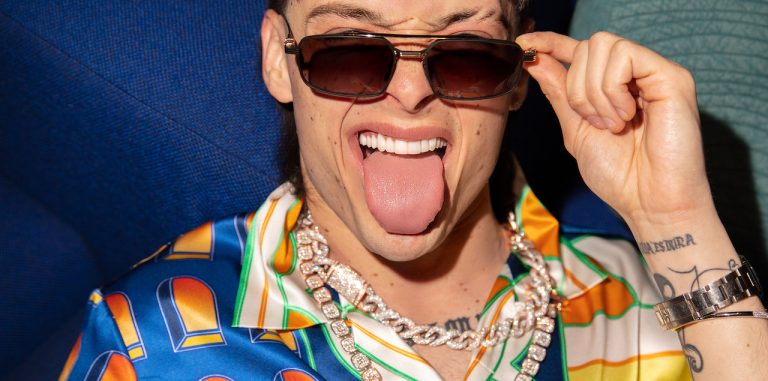
Latin American Creators Show Off Their Creativity With Video Podcasts
Many podcast hosts are getting up close and personal with fans in a new way—with video. Video podcasts introduce an extra dimension of interactivity and closeness, allowing listeners to watch facial reactions or take notice of a host’s environment. Some creators are even excited about getting dressed up and showing off their fashion-forward “lewks.”
The shift toward video podcasts is occurring around the world, and in the Latin American market, specifically, a few fan favorites are bringing this new layer to their shows.
Mexican creator Roberta Woodworth, whose podcast LIBRE&LOCA reflects on intimate and personal topics like self-love and heartbreak, is one of those creators currently experimenting with video in her newest season. The show Escuela de Nada, which is made by three Venezuelan friends based in Mexico, is also embracing video as a new way to connect with listeners. And then there’s multifaceted Mexican creator Juanpa Zurita, who introduced video for Season 2 of his Spotify Original podcast, No Hagas Lo Fácil.
Meanwhile, some new podcasts are incorporating video from the get-go. The Brazilian Spotify Original podcast Carona Podpah, featuring Igor Cavalari (known informally as Igão) and Thiago Marques (known as Mítico) from the popular podcast Podpah, premieres on Spotify June 7 and will include video for each of its weekly episodes. The show follows the hosts as they interview guests inside a car, making video an essential part of the podcast.
We caught up with Libre & Loca host Roberta, No Hagas Lo Fácil host Juanpa, Escuela de Nada founder and cohost Chris Andrade, and Carona Podpah hosts Igor and Thiago to learn how video is changing their podcast game.
What excites you most about introducing video to your podcast?
Igor Cavalari and Thiago Marques: Podpah started as a video podcast and the public has always enjoyed that aspect of it a lot—we were the most-listened-to podcast on Spotify in Brazil in 2022 and the 24th globally. Video is fundamental to our show format because we have entertainment as a background for everything we produce—whether we talk about cooking, soccer, or music. When a platform as relevant as Spotify is interested in a partnership with us for a video podcast, it shows us and the market that the product still has a lot to be explored.
Roberta Woodworth: My podcast is very intimate, and I think video invites the listener to get closer, reflect, and empathize even more with these “intimate, universal” topics we cover in Libre & Loca.
Juanpa Zurita: It was something my community asked me for in every episode of last season. So it makes me very happy that we made it for the second season! Listening is nice, but nothing compares to seeing. I think the connection and the dynamic of the podcast is more intimate than before. And people are happy, which makes me very happy!
Chris Andrade: Escuela de Nada, being an improvised comedy podcast, draws on the power of interaction in its videos with its fans. Being able to react to jokes and see the response of the followers has been a change that has excited us a lot.
How has video influenced the way you approach each episode?
Igor and Thiago: Video gives us freedom to create more and more. There are challenges—Carona Podpah involves filming in a tight space as we take our guests inside the car and learn more about the songs that have marked their lives—but that doesn’t hinder us from trying new things.
Roberta: I’m very expressive, and being on camera reminds me that the whole world is going to see my face. That in itself makes everything more human, organic, and real. I am no longer just a voice that accompanies you. I am a person.
Juanpa: There was a drastic change to our set to give it the NHLF look and feel we wanted. We also had to reinvent the intros of the episodes, and I’m really proud of the result.
Chris: Video has led us to have a new type of continuity and closeness with our fans. By being able to see and hear us as hosts, we’re noticing that the engagement from fans is much higher.
How is video helping you connect with your fans?
Igor and Thiago: The main characteristic of a video podcast is that the audience can experience reactions. What we like about having the video feature is that our audience will be able to follow the podcast as if they were with us in the car seeing everything that happened. Video makes the program more dynamic and allows us to establish a greater connection—not only with our guests, but with those on the other side of the screen.
Roberta: It brings us much closer because people not only hear what I think and feel, but also see it. And I talk so much about emotions, so it’s very interesting how that connection becomes deeper.
Juanpa: There’s something very special about body language, and you can’t feel that if you can’t see it. I also want to thank our fans for all the love during Season 1 and for everyone’s insistence on us using video. Without them we wouldn’t have made it.
Chris: Video has helped us further expand and disseminate our content to a social media platform where video is dominant. Each person has their own way of consuming content, and without a doubt, the video adds a lot to us and brings a lot of value to the new generations.










